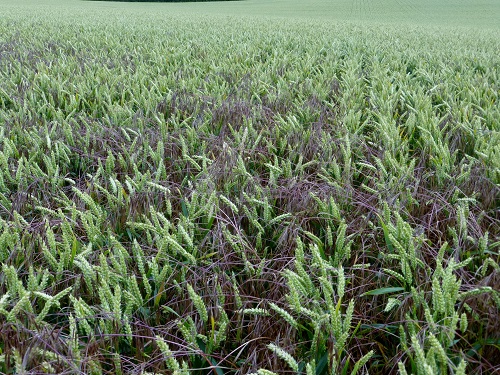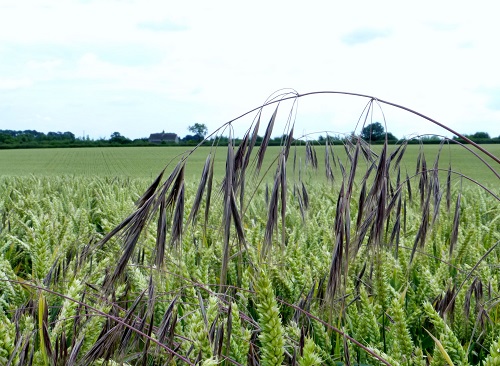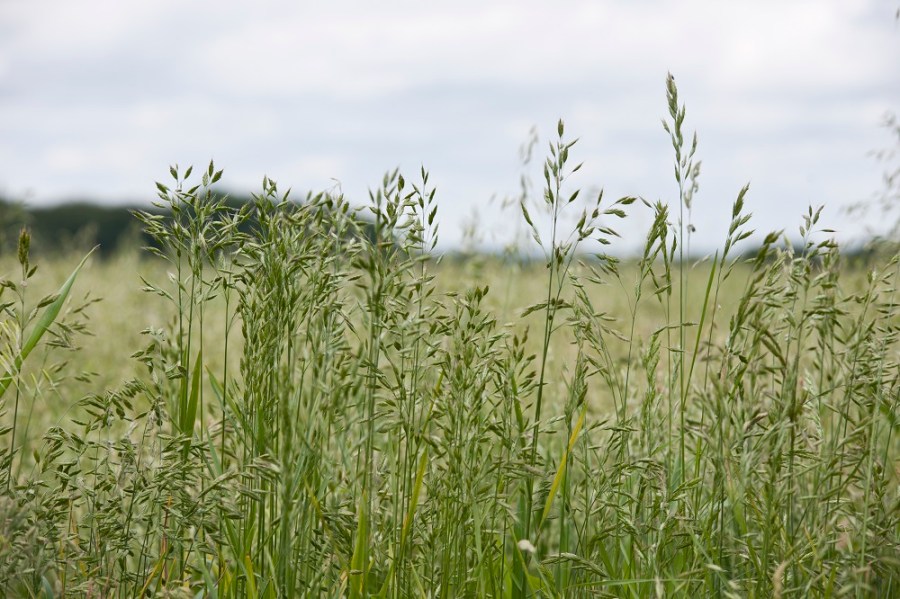Brome is an increasing problem on many farms, but do you know which species you’re dealing with? CPM gets some expert pointers on how to differentiate between the bromes and how to manage them.
Post-harvest management strategy varies, depending on the species present.
By Lucy de la Pasture
Grassweed identification can be tricky but it’s massively important when it comes to designing an effective control strategy, emphasises grassweed expert Dr Stephen Moss. For growers with a brome problem that means not just identifying brome, but pinpointing the species as well.

Sterile and great brome seeds are mature when shed so can germinate soon after harvest.
“There are five brome species that are commonly found in arable fields, with sterile or barren brome (Bromus sterilis) the most predominant. It’s crucial to identify brome species because the post-harvest management strategy varies, depending on the species present,” he explains.
To make matters easier, there’s a clear division between the bromes when it comes to the best post-harvest strategy. Sterile brome and great brome (Bromus diandrus) can be grouped together and are sometimes referred to as the Anisantha bromes.
“For these two species, light stops the seeds from germinating so a shallow cultivation, straight after harvest, will encourage a flush of the weed which can then be sprayed-off with glyphosate,” he comments.

Ploughing has traditionally been used for brome control but isn’t always effective.
But when it comes to the other three species – soft brome (Bromus hordaceous), meadow brome (Bromus commutatus) and rye brome (Bromus secalinus) – the opposite post-harvest management applies.
“For these three bromes, sometimes referred to as the Serrafalcus bromes, cultivations encourage dormancy because the seeds are immature when shed. It’s best to leave their seeds on the surface immediately after harvest so that they can ripen, and delay any cultivations ideally for a minimum of four weeks,” advises Stephen Moss.
But there are possible exceptions to these general rules, he adds. “Some research suggests that soft brome may behave as sterile and great brome when it comes to light exposure. The evidence is inconclusive but raises a question over whether soft brome should be grouped with rye and meadow brome when it comes to post-harvest cultivation strategy.”
Ploughing has widely been regarded as the standard control method for all bromes, but this isn’t always the case with great brome, he points out. “Great brome has a big seed, so seedlings can emerge from depth. Keeping populations in check using ploughing wasn’t borne out in the last brome survey, carried out in 1989, which may simply have been due to the depth and quality of the ploughing,” suggests Stephen Moss.
Increasingly problems with brome species are being reported across the UK, says ADAS weed scientist, Laura Davies. For that reason, AHDB have commissioned a brome survey to get a better picture of the distribution of species and to develop effective integrated control strategies before any major issues with the weed occur, she explains.
“Currently we don’t know how the brome population has changed over the past thirty years and whether this is linked to any issues with control. We expect some populations may be less sensitive to herbicides, so as part of the project we’ll be using seed collected and sent in during the survey and conducting glasshouse experiments to select for those plants less easily controlled and so assess the potential for resistance,” she explains.
Although resistance to herbicides in brome hasn’t been identified in UK populations, this may be simply because it hasn’t been looked for yet, reckons Stephen Moss and he’s looking forward to seeing the results from the ADAS work.
“Brome populations in both France and Germany have been reported to be resistant to ALS and ACCase herbicides so it’s something that needs looking at in the UK, especially as we rely heavily on the ALS inhibitor herbicides for brome control.
“We do see variation in response to herbicides in different brome species. Great brome and rye brome can be harder to control with herbicides but the impact of this in the field is unclear. As a self-pollinating weed, there is likely to be natural variation between different populations, which may not be resistance but could indicate an increased insensitivity to herbicides,” he adds.
Stephen Moss believes that populations of rye brome are probably underestimated and certainly greater than reported in the Atlas of British Flora (2002). Surprisingly, no rye brome at all was identified in the 1989 survey.
“It’s more difficult to distinguish between soft brome, meadow brome and rye brome and I suspect many soft brome problems are actually meadow or rye brome. All three species have oval-shaped spikelets with shorter awns and the spikelet is narrower towards the tip, a distinguishing feature from sterile and great bromes which have spreading awns on their spikelet and are broader at their tip,” he explains.
To identify between this group of three brome species, there are four botanical characteristics that need to be assessed. Looking at the panicles can be conclusive if the panicle is compact, with short pedicels (panicle branches) and hairy spikelets – the presence of all these features indicates the soft brome species.”
“Meadow and rye brome are much harder to tell apart. Both have a looser, spreading panicle with long pedicels. Meadow brome has hairless spikelets but in rye brome, these can be either hairless or hairy. So a lack of hairs on the spikelets isn’t a reliable indicator of species and these two species can’t be accurately told apart at the green panicle stage.
“To tell the difference between the two, seed shape is the most reliable indicator. When seeds are mature (late July-Aug) and cut in half, if the cross-section is saucer-shaped then it’s meadow brome but if it’s a deep ‘V’ or ‘U’-shape then it’s rye brome,” he explains.
Differentiating between sterile and great brome is a much simpler affair which involves looking at just two parameters, spikelet length and hairiness of the main stem of the panicle.
“Sterile brome has spikelets 40-60mm long and a virtually hairless panicle stem, whereas great brome has longer spikelets, 70-90mm long and the panicle stem is distinctly hairy,” he points out.
Stuart Jackson, customer agronomist for Dow AgroSciences, further explains that the seeds of sterile and great brome are mature at the point of harvest, which is why they will easily chit with light cultivation. Furthermore, if their seed is left undisturbed then the exposure to light will make them go dormant, he adds.
“For these species, avoid any sort of deep cultivation immediately post-harvest as this will just enforce dormancy. Both sterile and great brome will flush very easily in the autumn so stale seed beds and delayed drilling offer good control.
“For the other three species, there may not be the same opportunity to stale seedbed after cultivations have been delayed for at least four weeks post-harvest to allow the seeds to ripen.”
He recommends drilling from the second week of Oct into a fine, firm seedbed, and applying 1200g/ha pendimethalin plus flufenacet if blackgrass is also present (often applied in co-formulation as Crystal).
A further option to consider in wheat as part of the herbicide stack is ethofumesate (Xerton), adds Pam Chambers, UPL’s technical support manager.
“Xerton has activity on sterile brome but only pre-emergence of the weed. ADAS has carried out container trials to investigate the efficacy at both pre- and post-emergence application timings and the best control is obtained when used as a pre-emergence herbicide,” she explains.
The current Xerton label is for post-emergence application but UPL are working on getting the earlier timing as a label recommendation, as well as evaluating its activity on other brome species.
“Ethofumesate has a mode of action classified as class N, which is the same as prosulfocarb and triallate, but different to the ALS inhibitors (such as Broadway Star and Pacifica) so would be a good stacking partner as part of an anti-resistance strategy, as well as supplying additional control,” she adds.
“Any further flushes of brome in the autumn tends to be fast, so aim to follow up with Broadway Star (florasulum+ pyroxsulam) plus a further 800g pendimethalin (1.75l/ha Stomp Aqua) plus a good wetting, penetrative adjuvant,” advises Stuart Jackson.
“Ideally any follow-up with Broadway Star needs to be aimed at the 2-3 leaf stage of the brome and applied when it’s actively growing. This means application should be in a window when there’s two or more fine days either side. But if the weather turns cold, then it’s important to wait until warmer conditions return, which is typically a Feb-Mar spray window,” he adds.
As grass weeds increase in size, the efficacy of graminicides reduces. So if brome species reach a growth stage beyond mid-tillering, there will be a drop-off in herbicide performance, he highlights.
“Soft brome also has a spring flush, so there’s a case for delaying any follow-up applications to the spring timing when this is the main species. But it’s a balancing act.
“It’s important to take account of the size of the weed because any spring germination will be smaller than the one that occurred in the autumn and the most important thing is to not allow autumn germinated brome plants to get too big before treating,” he emphasises.
Mixed brome population identified
One grower who has seen a change in predominance of brome species on his Herefords farm is Graham Watkins.
“Fifteen years ago, we had sterile brome but over the past ten years, soft brome species have been on the increase. Mostly brome hasn’t been too much of a problem on the farm, but last season we had a real mess in some winter barley, so we’ve changed our herbicide strategy this year.”
So which brome species was it? Definitely not sterile brome, replies Graham Watkins. With the brome identification leaflet in-hand, Graham and his Procam agronomist, Tony Baker, set off across the farm to pinpoint the culprit.
Brome was only evident around the headland in the winter barley, following an effective autumn application of 0.5 l/ha Liberator (diflufenican+ flufenacet) plus 0.3 l/ha Movon (DFF+ flufenacet+ flurtamone). A few sterile brome plants were easy to identify but the more predominant soft brome species proved much trickier to tell apart, says Tony Baker.
A spray-miss in a nearby wheat field proved revealing, with poppy, mayweed and bromes standing tall having escaped a spring application of Pixxaro (halauxifen-methyl+ fluroxypyr) and follow-up treatment of Broadway Star (florasulam+ pyroxsulam).
Back at the car, Tony Baker’s hand lens and knife come to the rescue, revealing tiny hairs on the spikelets of the two ‘soft’ brome species found in the field.
“So it looks like we have soft brome and rye brome,” says Tony Baker, with the shorter pedicels and more compact panicle distinguishing the soft brome. To make absolutely sure, he finds some mature-looking seeds to cut in half. Sure enough, one of the cross-sections was a deep V-shape, indicating rye brome, while the other was the saucer-shape expected in soft brome.
Survey to check status of UK arable brome weeds
Farmers and agronomists are being asked to complete an online survey to help map the distribution of brome weeds across UK arable farms. The results, alongside experimental data, will be used to map population changes and establish the implications for weed management.
The survey can be accessed via cereals.ahdb.org.uk/brome until Friday 18 August.
ADAS is also providing an option to send in seed samples for identification and herbicide testing.
Inside this month’s issue is a new brome identification leaflet, written by Stephen Moss Consulting and produced at Rothamsted Research for the Croprotect knowledge transfer initiative. Dow AgroSciences and UPL have jointly funded printing and distribution.




